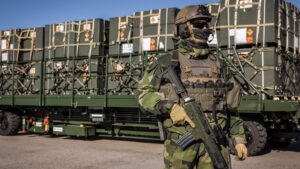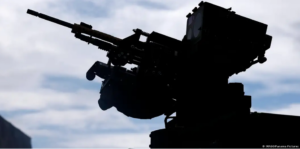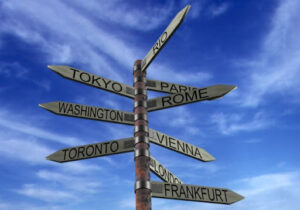Germany’s central bank expects the country’s economy to grow in April-June for the second consecutive quarter after falling at the end of 2023.
According to preliminary calculations of the statutory office of the Federal Republic of Germany, in January-March GDP increased by 0.2% compared to the previous three months. It fell 0.5% in October-December 2023.
“The economy is likely to expand slightly again in the second quarter,” the Bundesbank said in a statement on Wednesday.
Activity in the services sector was likely to have continued to strengthen on the back of rising household income and consumer spending.
“Growth in household disposable income is likely to take the upper hand from consumer uncertainty,” Central Bank analysts suggested.
However, they noted that the construction sector remains very weak.
The German labor market is expected to remain resilient and wages look set to continue to rise rapidly. This could be a risk to cooling inflation, which the Bundesbank estimates will accelerate slightly again in May.
The final data on Germany’s first-quarter GDP dynamics will be released on May 24, while preliminary information for the second quarter will be presented on July 30.
Earlier Experts Club analytical center and Maxim Urakin released a video analysis of how the GDP of the world’s countries has changed over the past years, more detailed video analysis is available here – https://youtu.be/w5fF_GYyrIc?si=BsZmIUERHSBJrO_3.
Subscribe to Experts Club YouTube channel here – https://www.youtube.com/@ExpertsClub
CENTRAL BANK, ECONOMY, EXPERTS CLUB, GDP, GERMANY, MACROECONOMICS, URAKIN

The Swedish government intends to provide long-term support to Ukraine through a three-year military support program (2024-2026) totaling SEK 75 billion (EUR 6.5 billion), the Swedish government website reports.
“In order to strengthen Swedish support for Ukraine, as well as to strengthen the long-term perspective, the government and the Sweden Democrats agree to introduce a military support program for Ukraine for 2024-2026. Sweden will increase its support, and its volume will amount to SEK 75 billion in military support for 2024-2026, SEK 25 billion per year,” the statement said.
It is noted that Sweden’s total military and civilian support for Ukraine, taking into account this proposal, will amount to more than SEK 100 billion. Military support within Ukraine can, for example, take the form of free transfer of defense equipment, financial contributions and financial support for the purchase of defense equipment.
The government also noted that, depending on the type of support used, the program’s framework could burden public finances for several years and even beyond 2026.
Following the Russian invasion in February 2022, Sweden has allocated the equivalent of SEK 37 billion for various efforts to support Ukraine. In particular, through 15 military support packages totaling about SEK 30 billion, and that Ukraine is now the largest country where Swedish aid is directed.

Governments face increased borrowing, taxes and public sector cuts to finance their soaring military budgets. European NATO members are set to spend a record $380 billion on defense this year — a tough sell to voters.
If you want a reminder of the security threats faced by the world today, take a look at how much governments have hiked defense spending. Global military budgets reached $2.44 trillion (€2.25 trillion) last year, nearly 7% higher than in 2022. It was the steepest year-on-year rise since 2009, recorded during the second year of Russia’s full-scale invasion of Ukraine. For every man, woman and child, world military spending is now at its highest since the end ofthe Cold War — at $306 per person.With Kyiv unprepared to fight such a large-scale conflict, Western countries ramped up military aid to Ukraine, while other escalating tensions with Russia and in the Middle East and Asia also prompted governments to shore up their defenses, unlike any time since World War II.
In 2024, the United States has allocated $886 billion for defense, a rise of more than 8% over two years. For the first time, NATO’s European partners are projected to meet the target set by the military alliance of spending 2% of gross domestic product (GDP) — a major bugbear of former US President Donald Trump, as many weren’t. This year alone, they’ve budgeted a collective $380 billion on defense, NATO chief Jens Stoltenberg said in February.
Poland leads the way (measured by GDP)
While Germany is still playing catch up with other NATO members — helped by Chancellor Olaf Scholz’s special €100 billion ($109 billion) fund to upgrade the Bundeswehr armed forces — Poland is due to spend 4.2% of GDP on defense this year, the highest in the military alliance. Others on NATO’s eastern flank also far exceed or will soon surpass the 2% target, due to the heightened security threat on their borders.
As a result, governments are facing an increasingly tough choice over how to pay for those new defense commitments, just as many economies weaken due to the effects of the ongoing global geopolitical tensions and lingering inflation. Many countries are already fiscally stretched.
“Short-term commitments for military equipment for Ukraine should be financed with additional debt. That’s the way wars have historically been funded,” Guntram Wolff, a senior fellow at the Brussels-based think tank Bruegel, told DW. “But for longer-term increased defense spending, either taxes need to go up or you cut other spending.”
“Is it painful politically? Sure! But if you spread it across the various government departments, it will be less so.”
Germany cuts ministry budgets, apart from defense
Germany, which faces the prospect of lower tax revenues due to weaker growth, has slashed spending across most government departments and has singled out international development aid for an almost €2 billion cut this year.
“Germany has some very significant trade-offs to make,” Jeffrey Rathke, president of the American-German Institute at the Johns Hopkins University in Washington D.C., told DW. “They need to be managed politically so that they don’t erode public support for strengthened security and defense.”
Leftist political parties in several countries have led calls for peace between Russia and Ukraine and have stoked the debate over whether the new military spending could be better spent on health care or social programs.
Rathke noted how Germany’s debt brake, which limits the government’s ability to borrow money to cover gaps in the budget, meant that Scholz’s coalition has less wiggle room compared to, say, France.
While Poland’s finances are in much better shape than many Western European countries, Prime Minister Donald Tusk, who ousted the right-wing populist government last October, is struggling to deliver on election promises, including raising the limit before income taxes are levied, due to the much higher defense budget.
Other EU states struggle with NATO target
Other countries, such as those hit worst by the 2011 European debt crisis, have already faced deep austerity measures and any further cuts could affect the quality of public services.
Italy, for example, is expected to spend just 1.46% of GDP on defense this year and warned that meeting NATO’s 2% target by 2028 would be tricky. The country’s debt-to-GDP ratio is forecast to hit 137.8% this year.
Other countries in similar fiscal tight spots, like Spain, could find limits on any additional deficits needed to fund new military spending, which could be anything from 0.5% to 1.5% of GDP. Last year, Madrid hiked its defense budget by 26%.
“The European debt crisis forced budgetary adjustments of 5% to 7%, even 10% for Greece,” Wolff said. “Fortunately, these cuts will be much less painful than anything the European south had to endure.”
Sweden, Norway, Romania and the Netherlands have lower debt burdens. But even so, Dutch far-right firebrand Geert Wilders also plans significant spending on social security housing and agriculture to ensure his new four-party coalition holds.
“As well as the fiscal capacity and the indebtedness problems, this resource debate is overlaid on an ongoing difference of threat perception across Europe,” Rathke said, so countries located further from Ukraine may be less keen to prioritize defense than those near its border.
Next target: 3%?
Defense spending is expected to keep increasing over the next decade. NATO’s 2% defense spending target was first set in 2014 after war broke out between the Ukrainian military and Russian-backed separatists in the east of the country and Moscow annexed Ukraine’s Crimea peninsula.
Last year, at a meeting in Vilnius, Lithuania, NATO leaders agreed that the target could often exceed 2%. Germany, which until now has struggled to meet the original target, has now mooted the prospect of a 3% budget target, which would have even bigger ramifications for government finances.

International tourism revenues reached $1.5 trillion in 2023, which means a full recovery to the level of pre-pandemic 2019 in nominal terms and by 97% adjusted for inflation, according to the United Nations World Tourism Organization (UN Tourism).
According to the organization, Europe received the highest revenues from international tourism – $660 billion, which is 7% more than in pre-pandemic 2019. Revenues in the Middle East increased by 33%. Last year, America recovered 96% of its pre-pandemic international tourism revenues, Africa – 95%, and the Asia-Pacific region – 78%.
According to UN Tourism, in 2023, GDP from tourism recovered to the level of 2019. It is estimated to have amounted to $3.3 trillion, or 3% of global GDP.
As noted, several destinations achieved outstanding results in terms of international tourism revenues in the first quarter of 2024 compared to 2019. Among them are Serbia (plus 127%), Turkey (plus 82%), Pakistan (plus 72%), Tanzania (plus 62%), Portugal (plus 61%), Romania (plus 57%), Japan (plus 53%), Mongolia (plus 50%), Mauritius (plus 46%) and Morocco (plus 44%).

In the framework of international cooperation and cultural exchange, representatives of the Embassy of the Republic of Kazakhstan in Ukraine visited the Central State Historical Archive of Ukraine in Kyiv. The main purpose of the visit was the ceremony of handing over digital copies of the Kamianets-Podilskyi Armenian Voytov Court record books written in the Armenian-Kipchak language.
The ceremony was attended by counselors of the Embassy Alibek Alibekov, Yevgeniy Katrenov and Daniyar Satybaldin, director of the Central State Historical Archive of Ukraine Yaroslav Fayzulin, as well as archive staff and representatives of Kazakh business.
These unique historical documents are of great importance for the cultural heritage and history of both Ukraine and Kazakhstan. They testify to the rich cultural and historical ties between the peoples who lived on the territory of modern Ukraine and Kazakhstan.
The representatives expressed special gratitude to Kazakh businessman and philanthropist Aidyn Rakhimbayev, who made it possible to obtain these historical documents. Aidyn Rakhimbayev is known for his numerous charitable projects and support of cultural initiatives. In gratitude for his cooperation, five modern computers were donated to the Central State Historical Archive of Ukraine on behalf of Mr. Rakhimbayev.

This gesture contributes to strengthening bilateral relations between the two countries, as well as supports the preservation of historical heritage and the development of cultural ties.
Ancient Kipchak books are handwritten documents created in the Middle Ages, when the Kipchaks (Polovtsians) were one of the most powerful nomadic peoples in Eastern Europe and Central Asia. These books contain valuable historical, legal, and literary texts that reflect the social life, traditions, and legal systems of the time.
The Armenian-Kipchak language is considered to be a unique historical and linguistic phenomenon that arose as a result of the long coexistence of Armenian and Kipchak communities on the territory of modern Ukraine. This language was used by Armenians living in the Crimea, Kamianets-Podilskyi, and other cities where the Kipchaks had significant influence. The Armenian-Kipchak language is a mixed language that combines elements of the Kipchak (Polovtsian) and Armenian languages, making it a unique cultural heritage.
The Kamianets-Podilskyi Armenian Voytiv Court was a judicial institution that operated in Kamianets-Podilskyi during the Middle Ages. It resolved legal issues of the local Armenian community. The record books of this court are valuable sources on the history of law, ethnography, and social life of the society of that time. These books have been stored in the archive for centuries and have now become available thanks to their digitization.

Kazakhstan has now received digital copies of unique ancient Kipchak books, which are now available for study and research, enriching the historical heritage of both countries.
On July 22, 1992, the Republic of Kazakhstan and Ukraine established diplomatic relations. And in December 1994, the Embassy of the Republic of Kazakhstan in Ukraine was opened.

Ribas Hotels Group is expanding its network to Moldova, with the management of the Tree House Relax Park hotel complex in Chisinau starting on June 1, the company’s press service reports.
“The opening of Tree House Relax Park is a strategic step in the expansion of the Ribas Hotels Group network abroad, which helps to strengthen the company’s position in the international hospitality market. Thanks to its location, high-quality amenities and integration of the company’s best practices, the complex has every chance to become a popular destination for leisure and business events in Moldova,” said Yulia Kosenko, CEO of Ribas Management.
Tree House Relax Park has been operating since 2013 and is aimed at nature lovers and conscious eco-vacationers, from couples with children to business travelers. The park offers comfortable cottages and villas with a sauna, a swimming pool, gazebos, a restaurant and a conference room for business and festive events, and a parking lot for 250 cars.
Artur Lupashko, founder of Ribas Hotels Group, told Interfax-Ukraine that at this stage the company is taking the hotel complex under management, and that its renovation and expansion are planned for the future, with the development concept to be presented later.
Ribas Hotels Group, which has been operating since 2014, is an international management company whose flagship service is the operational management of hotel and restaurant complexes. The company also provides concept development, design, support for all stages of project implementation, consulting, and franchising services for developers.
Its portfolio includes 55 hotels under management and construction, including five projects in Bali. The operator’s total room capacity is over 1000 rooms.
Currently, the company is developing properties in Poland, Montenegro, Austria, Switzerland, Germany, Georgia, Armenia, Italy, and East Asia.